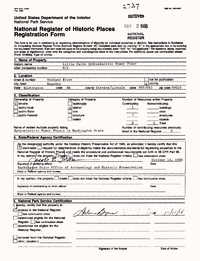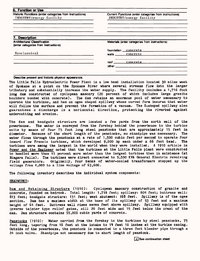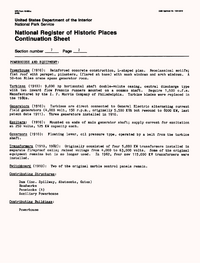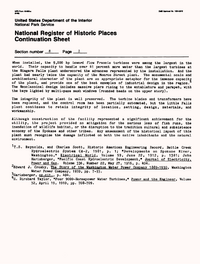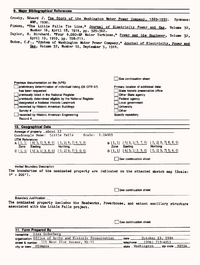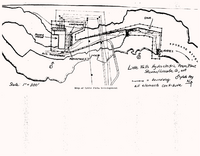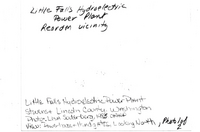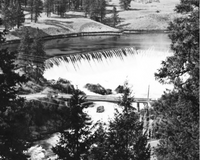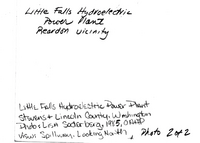Little Falls Dam National Registry of Historic Places
This is basically a historic document concerning the registration of Little Falls dam (also known as the Little Falls Hydroelectric dam) as a National Registry of Historic Place. The format has been changed in two ways. First the two repositories in the Library of Congress have been merged to give each other more context. Second, some liberty has been applied to the document to remove the paper structure (especially continuation pages and some data field formatting). Footnotes have been converted to end notes. No data has been deleted and the originals are also accessible. Edit this document only to correct transcription and typographical errors.
The original document for the text form only is here. The original document for the submitted photos is here.
NPS Form 10-900
(OMB No. 1024-0018)
(Rev. 8-86)
United States Department of the Interior A National Park Service
National Register of Historic Places
Registration Form
This form is for use in nominating or requesting determinations of eligibility for individual properties or districts. See instructions in Guidelines for Completing National Register Forms (National Register Bulletin 16). Complete each item by marking ‘'x” in the appropriate box or by entering the requested information. {f an item does not apply to the property being documented, enter “N/A” for “‘not applicable.” For functions, styles, materials, and areas of significance, enter only the categories and subcategories listed in the instructions. For additional space use continuation sheets (Form 10-900a). Type all entries.
1. Name of Property
historic name: Little Falls Hydroelectric Power Plant
other names/site number: N/A
2. Location
street & number: Spokane River [_] not for publication
city, town: Reardan [x] vicinity
state: Washington code: WA county: Stevens/Lincoln code: 065/043 zip code 99029
3. Classification
Ownership of Property
[x] private
[_] public-local
[_] public-State
[_] public-Federal
Category of Property
[_] building(s)
[x] district
[_] site
[_] structure
[_] object
Number of Resources within Property
| Contributing ! Noncontributing | ||
|---|---|---|
| 1 | buildings | |
| sites | ||
| 7 | structures | |
| objects | ||
| 8 | 0 | Total |
Number of contributing resources previously listed in the National Register: O
Name of related multiple property listing: Hydroelectric Power Plants in Washington State
4. State/Federal Agency Certification
As the designated authority under the National Historic Preservation Act of 1966, as amended, I hereby certify that this ([x] nomination [_] request for determination of eligibility meets the documentation standards for registering properties in the National Register of Historic Place$ and meets the procedural and professional requirements set forth in 36 CFR Part 60. In my opinion the property [x] meets [_] does not meet the National Register criteria. [_] See continuation sheet.
| Jacob E. Thom | October 12, 1988 |
| Signature of certifying official | Date |
Washington State Office of Archaeology and Historic Preservation
State or Federal agency and bureau
In my opinion, the property [x] meets [_]does not meet the National Register criteria. [_]see continuation sheet.
Signature of commenting or other official Date
State or Federal agency and bureau
5. National Park Service Certification Phones certify that this property is:
[x] entered in the National Register. [_] see continuation sheet.
[_] determined eligible for the National Register. [_] see continuation sheet.
[_] determined not eligible for the National Register.
[_] removed from the National Register.
[_] other, (explain:)
| Delores Byer | 12/15/88 |
| Signature of the Keeper | Date of Action |
6. Function or Use
Historic Functions (enter categories from instructions)
INDUSTRY/energy facility
Current Functions (enter categories from instructions)
INDUSTRY/energy facility
7. Description
Architectural Classification (enter categories from instructions)
Neoclassical
Materials (enter categories from instructions)
foundation: concrete
walls: concrete
roof: concrete
other:
Describe present and historic physical appearance.
The Little Falls Hydroelectric Power Plant is a low head installation located 30 miles west of Spokane at a point on the Spokane River where several streams flow into the larger tributary and substantially increase the water supply. The facility includes a 1,716 foot long dam constructed of cyclopean masonry (20 percent of which includes large granite boulders bonded with concrete). The dam retains an enormous pool of water necessary to operate the turbines, and has an ogee shaped spillway whose curved form insures that water will follow the surface and prevent the formation of a vacuum. The S-shaped spillway also guarantees a discharge in a horizontal direction, protecting the riverbed against undercutting and erosion.
The dam and headgate structure are located a few yards from the north wall of the powerhouse. The water is conveyed from the forebay behind the powerhouse to the turbine units by means of four 75 foot long steel penstocks that are approximately 15 feet in diameter. Because of the short length of the penstocks, no standpipe was necessary. The water flows through the penstocks at a rate of 1,500 cubic feet per second to operate four inward flow Francis turbines, which developed 9,000 hp each under a 66 foot head. The turbines were among the largest in the world when they were installed. A 1910 article in Power and the Engineer noted that the turbines at the Little Falls plant were constructed to handled more than 41 percent more water than the largest turbines then in existence (at Niagara Falls). The turbines were direct connected to 5,500 KVA General Electric revolving field generators. Originally, four banks of water-cooled transformers stepped up the voltage from 4,000 to a line voltage of 63,600.
The following inventory describes the individual system components:
HEADWORKS:
Dam_and Retaining Structure (1910): Cyclopean masonry construction of granite and concrete, founded on bedrock. Total length: 1,716 feet; spillway: 604 feet; buttress wall: 813 feet; headgate structure: 131 feet; west abutment: 168 feet. Spillway is of the ogee section. Dam has a maximum width at the base of its spillway of 53 feet and a maximum height of 64 feet. Buttress wall rises seven feet above spillway. Spillway equipped with inverse tainter type relief gates, sill 20 feet wide and 15 feet below the crest of the dam. Dam structure contains 55,000 cubic yards of concrete.
Penstocks (1910): Water carried from the forebay to the turbines by steel penstocks, 75 feet long, tapering from 16 feet at the intake to 14 feet 10 inches at the turbine casing. Outside of the powerhouse, the penstock is connected to a three foot bleeder pipe through a 24 inch valve. Standpipe not necessary due to short length of penstock.
[x]See continuation sheet
NPS Form 10-900-a (OMB Approval No. 1024-0018)
United States Department of the Interior
National Park Service
National Register of Historic Places
Continuation Sheet
Section number:7 Page: 2
POWERHOUSE AND EQUIPMENT:
Powerhouse (1910): Reinforced concrete construction, L-shaped plan. Neoclassical motifs; flat roof with parapet, pilasters, (flared at base) with sash windows and arch windows. A 50-ton Niles crane spans generator room.
Turbines (1910): 9,000 hp horizontal shaft double-volute casing, central discharge type with two inward flow Francis runners mounted on a common shaft. Require 1,500 c.f.s. Manufactured by the I. P. Morris Company of Philadelphia. Turbine blades were replaced in the 1980s.
Generators (1910): Turbines are direct connected to General Electric alternating current field generators (4,000 volt, 150 r.p.m., originally 5,500 KVA but rewound to 8000 KW, last patent date 1911). Three generators installed in 1910.
Exciters: (1910): Mounted on ends of main generator shaft; supply current for excitation at 250 volts, 125 KW capacity each.
Governors (1910): Floating lever, oil pressure type, operated by a belt from the turbine shaft.
Transformers (1910, 1982): Originally consisted of four 5,000 KW transformers installed in separate fireproof cells; raised voltage from 4,000 to 63,000 volts. Some of the original equipment remains but is no longer used. In 1982, four new 115,000 KV transformers were installed.
Switchboard (1910): Two of the original marble control panels remain.
Contributing Structures:
Dam (inc. Spillway, Abutments, Gates)
Headworks
Penstocks (4)
Auxiliary Powerhouse
Contributing Buildings:
Powerhouse
8. Statement of Significance
Certifying official has considered the significance of this property in relation to other properties: [_]nationally [x]statewide [_]locally
Applicable National Register Criteria [x]A [_]B [x]C [_]D
Criteria Considerations (Exceptions) [_]A [_]B [_]C [_]D [_]E [_]F [_]G
Areas of Significance (enter categories from instructions)
Engineering
Industry
Architecture
Period of Significance: 1907-1938
Significant Dates: 1910
Cultural Affiliation: N/A
Significant Person: N/A
Architect/Builder Washington Water Power Company
State significance of property, and justify criteria, criteria considerations, and areas and periods of significance noted above.
The Little Falls Hydroelectric Power Plant is a significant low head hydroelectric installation from the early 20th century. Built in 1907-1910, the plant was the first large-scale regional generating facility constructed by the Washington Water Power Company. As such, the plant was critical to the growth of industry and agriculture in the Inland Empire. In addition, the powerhouse is an architecturally significant example of industrial design from the period. The well preserved complex meets the registration requirements established in the Hydroelectric Power Plants in Washington multiple property documentation form.
Historical Background: In an effort to keep pace with the growing load demands of the city of Spokane and surrounding agricultural and mining districts, the Washington Water Power Company began construction of the Little Falls plant in 1907. It was the third large facility completed by the company, and reflected the rapid growth of the utility in the first decade of the 20th century. Like electrical companies elsewhere in the West, Washington Water Power cultivated a diverse power load from its inception. The company provided power not only to residential and commercial users in Spokane, but also supplied electricity to farmers, farming communities, irrigation pumps, mines, cement mills, and interurban railroads.[1] As the population of the region escalated, the need for more power plants became critical; in 1906, the company reported that it would have "to maintain a more or less continuous power plant construction and development program in order to keep up with its load growth." The construction of the Little Falls plant was a critical part of this development program.[2]
By 1907, load demand taxed the capacity of the company's two existing plants. The 8,000 KW Monroe Street Plant in the center of the city could carry only a fraction of the load. Additional power was furnished to the city by the 9,000 KW Post Falls Plant completed in 1906. However, the primary function of the latter plant was to serve mining districts in Northport and Coeur d'Alene. And even then, according to an engineering journal of the day, the Post Falls plant carried a continuous load with nearly a 100 percent load factor. Because of the enormous load, the company could no longer guarantee continuous service during low water periods. Thus, when the 20,500 KW installation was completed at Little Falls in 1910, it served to regulate the entire system, and to insure sufficient power for dependable, uninterrupted station operation.[3]
[x] See continuation sheet
NPS Form 10-900-a (OMB Approval No. 1024-0018
United States Department of the Interior
National Park Service
National Register of Historic Places
Continuation Sheet
Section number: 8 Page: 2
When installed, the 9,000 hp inward flow Francis turbines were among the largest in the world. Their capacity to handle over 41 percent more water than the largest turbines at the Niagara Falls plant underscored the advances represented by the installation. And the plant had nearly twice the capacity of the Monroe Street plant. The monumental scale and architectural character of the plant are an appropriate metaphor for the immense capacity of the plant, and provide one of the best examples of industrial design in the region. [4] The Neoclassical design includes massive piers rising to the entablature and parapet, with the bays lighted by multi-pane sash windows (rounded heads on the upper story).
The integrity of the plant is well preserved. The turbine blades and transformers have been replaced, and the control room has been partially automated, but the Little Falls plant continues to retain integrity of location, setting, design, materials, and workmanship.
Although construction of the facility represented a significant achievement for the utility, the project provided no mitigation for the serious loss of fish runs, the inundation of wildlife habitat, or the disruption to the tradition cultural and subsistence economy of the Spokane and other tribes. Any assessment of the historical impact of this plant must recognize the damage inflicted on both the native inhabitants and the natural environment. ---
9. Major Bibliographical References
Crosby, Edward J. The Story of the Washington Water Power Company, 1889-1930. Spokane: WWP, 1930.
Fisken, "The Little Falls Tie Line," Journal of Electricity Power and Gas, Volume 32, Number 16, April 18, 1914, pp. 329-362
Taylor, H. Birchard. "Four 9,000-HP Water Turbines," Power and the Engineer, Volume 32, April 19, 1910, pp. 708-711.
Unden, C.F., "System of Washington Water Power Company," Journal of Electricity, Power and Gas, Volume 32, Number 10, September 5, 1914.
[_] See continuation sheet
Previous documentation on file (NPS):
[_] preliminary determination of individual listing (36 CFR 67) has been requested
[_] previously listed in the National Register
[_] previously determined eligible by the National Register
[_] designated a National Historic Landmark
[_] recorded by Historic American Buildings Survey #:
[_] recorded by Historic American Engineering Record #.
Primary location of additional data:
[_] State historic preservation office
[_] Other State agency
[_] Federal agency
[_] Local government
[_] University
[_] Other
Specify repository:
10. Geographical Data
Acreage of property: about 12
Quadrangle Name: Little Falls Scale: 1:24000
UTM References
A: 11/431380/529950
B: 11/431380/529750
C: 11/431570/529880
D: 11/431250/529560
Zone Easting Northing
[_]See continuation sheet
Verbal Boundary Description
The boundaries of the nominated property are indicated on the attached sketch map (Scale: 1" = 200').
[_] see continuation sheet
Boundary Justification
The nominated property includes the Headworks, Powerhouse, and extant ancillary structure associated with the Little Falls project.
[_] See continuation sheet
11. Form Prepared By
name/title: Lisa Soderberg
organization: Office of Archy and Historic Preservation
date: October 23, 1986
street & number: 111 West 21st Avenue, KL-11
telephone: (206) 753-4011
city or town: Olympia state: Washington zip code: 98504
References
- ↑ T. S. Reynolds, and Charles Scott, Historic American Engineering Record, Battle Creek Hydroelectric System CA-2, 1981, p. 1; "Developments on Spokane River, Washington," Electrical World, Volume 59, June 22, 1912, p. 1381; John Harisberger, "Pacific Coast Hydroelectric Development," Journal of Electricity, Power and Gas. Volume 336, Number 22, May 27, 1916, p. 404.
- ↑ Edward J. Crosby, The Story of the Washington Water Power Company 1889-1930, Washington Water Power Company, 1930, pp. 7-33.
- ↑ Harisberger, op.cit., p. 404.
- ↑ H. Birchard Taylor, "Four 9000-Horsepower Water Turbines," Power and the Engineer, Volume 32, April 19, 1910, pp. 708-709.
Map of Little Falls Development.
Little Falls Hydroelectric Power Plant
Reardan vicinity
Little Falls Hydroelectric Power Plant
Stevens and Lincoln counties, Washington
Photo: Lisa Soderberg, 1985 OAHP
View: Powerhouse and headgates looking north
Photo 1 of 2
Little Falls Hydroelectric Power Plant
Reardan vicinity
Little Falls Hydroelectric Power Plant
Stevens and Lincoln counties, Washington
Photo: Lisa Soderberg, 1985 OAHP
View: Spillway looking north
Photo 2 of 2
